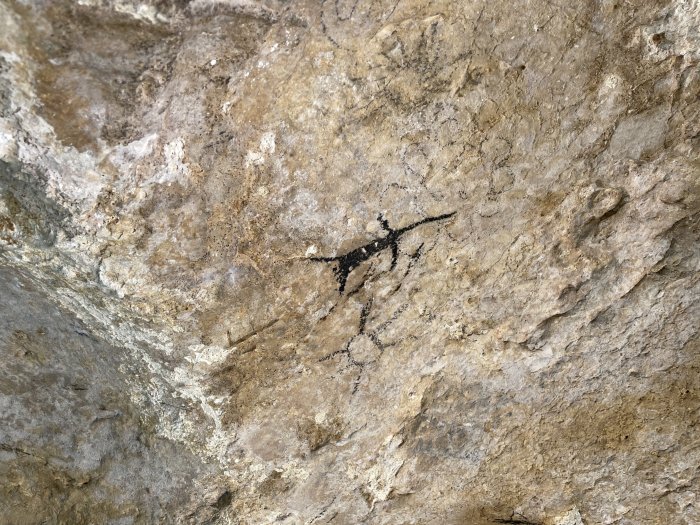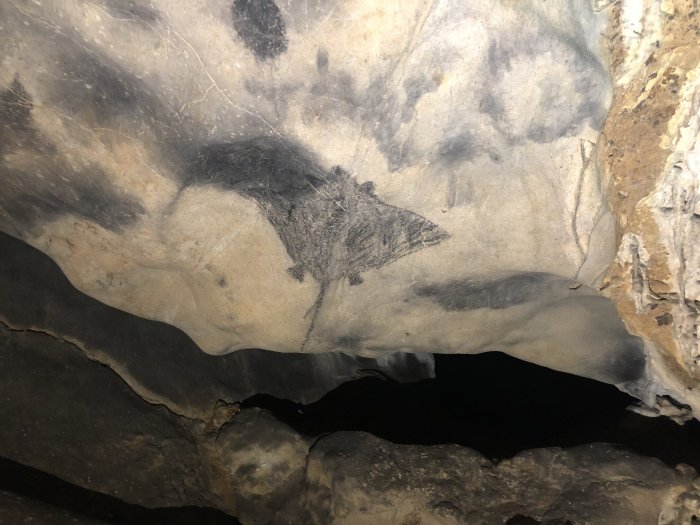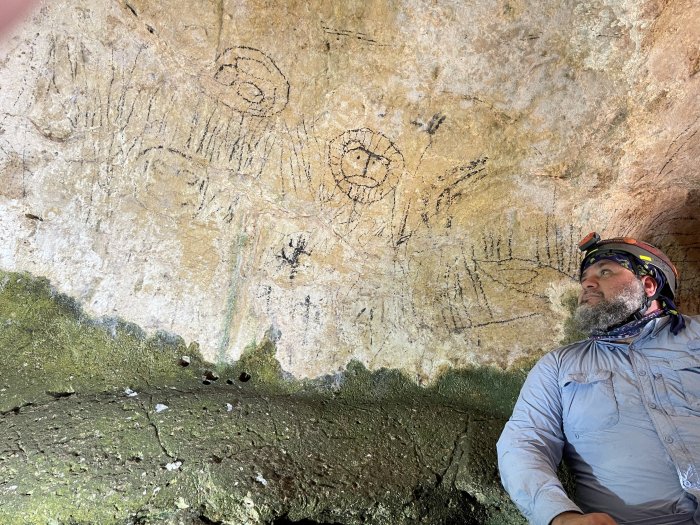Jan Bartek – AncientPages.com – In the karstic caves of Puerto Rico, cave art paints the rock walls. Previous research has ᴀssigned ages to this art based on the ages of nearby archaeological artifacts within the caves, but these ages are relative and may not reflect the true timing of the art creation.
Now, a new study to be presented Wednesday at the Geological Society of America’s GSA Connects 2023 meeting shows that researchers have refined the age of this rupestrian art by dating the pigment in the drawings. Angel Acosta-Colon, a geophysicist at University of Puerto Rico (UPR) at Arecibo, will present the findings.

Cave art can sometimes include two different times of creation. In this image, the darker lizard is a younger drawing than the sun that is drawn beneath it. Credit: A. Acosta-Colon.
In Puerto Rican caves, there are three types of art: petroglyphs (carved into the rock), pyroglyphs (drawn from the burnt remnants of objects), and pictographs, or cave drawings. Acosta-Colon says these pictograph drawings are in organic black material, perfect for radiocarbon dating.
Acosta-Colon and his colleague Reniel Rodríguez, an archaeologist at UPR Utuado, visited 11 different caves on La Isla Grande, the big island of the Puerto Rican archipelago. From these caves, they sampled 61 pigments in pictographic art.
The researchers were thoughtful about which art to sample, sampling art that is commonly seen and not unique. “[The pictographs] are not an infinite resource—they are limited,” explains Acosta-Colon. “So if we touch one, we touch it forever and for the future generations, we are not allowing the pleasure of seeing what we see.”

Over time, the cave art transitioned from more basic geometric shapes, to detailed images of recognizable animals, like this sting ray. Credit: A. Acosta-Colon.
They were also conservative about how much of the material they collected, as sampling destroys a small area of the art. Acosta-Colon says that they take 1 to 2 mg samples from the black markings on cave walls for their analyzes.
They ran the microsamples through the Center for Applied Isotope Studies (AIS) at the University of Georgia to get carbon-14 ages for the artwork. The earliest pictographs of abstract, geometrical shapes were dated to ca. 700–400 BCE, coinciding with the Archaic Age.
“That is very important to us because when the European Invasion came to Puerto Rico, they put in a document that our precolonial population was only there for 400 to 500 years,” says Acosta-Colon. “So this proves that we were here [thousands] of years before the European Invasion, and that is documented in science, not context archaeology.”
They found that more anthropological-type drawings—with simple shapes of human bodies—were drawn between 200 and 400 CE. “We have gaps of time and that’s interesting because we don’t know what happened,” says Acosta-Colon, adding that they could fill those gaps with more sampling around the island.
The research team also found more detailed human and animal drawings that were created between 700 and 800 CE. These types of drawings continued throughout the next century, extending through European colonization (around 1500 CE), and include images of horses, ships, and other animals.

Angel Acosta-Colon (shown here) poses with a number of pictographs, including an unusual find—an animal that looks like a lion. He speculates that this may be the first cave art drawn by slaves that were brought to the island during Spanish colonization. Credit: A. Acosta-Colon.
Within the array of animals, they discovered a particularly unusual find. “We have an image that looks like a lion—but in Puerto Rico, we don’t have lions,” says Acosta-Colon. When he and Rodriguez considered who could have seen a lion, they thought about the slaves that were brought to the island by the Spanish.
The idea, he notes, is controversial. “But the age of the art is around 1500,” he says. “We have data to corroborate what, I think, is one of the first slave art in caves in Puerto Rico.”
See also: More Archaeology News
Understanding when these pictographs were created helps explain the history of the Puerto Rican people, says Acosta-Colon. “Normally we get the European history version of Puerto Rico, but this is direct evidence that the story in Puerto Rico didn’t start with the European Invasion, it started much, much earlier in history,” he notes.
He believes that studying more cave art sites may push back the human history record to 5000 BCE. This art, along with archaeological finds, can reconstruct the “history of our people, from Archaic people, to the Taino people to the pre-Columbian time.”
The study was provided by Geological Society of America
Written by Jan Bartek – AncientPages.com Staff Writer





